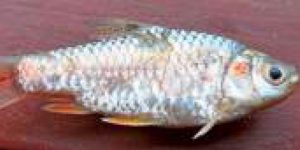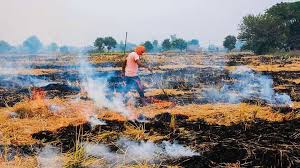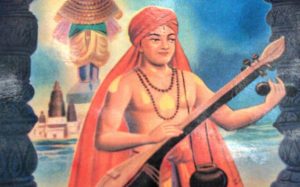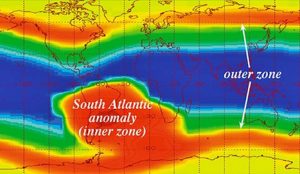Table of Contents
Daily Current Affairs for Government Exams:
Today Current Affairs:26th May 2020 for UPSC IAS exams, State PSC exams, SSC CGL, State SSC, RRB, Railways, Banking Exam & IBPS, etc
Contents:
- Puntius Sanctus :
- Heat Waves:
- Stubble burning:
- .Purandara Dasa
- Magnetic field around the earth
- The India-China border dispute:
- Other important current affairs:
1. Puntius Sanctus :

Velankanni in Tamil Nadu has thrown up a new species of small freshwater fish of the family Cyprinidae. The silver-hued fish has been christened Puntius Sanctus — ‘Sanctus’ is Latin for holy — after the popular pilgrim town.
- Encountered in a small waterbody in Velankanni, Puntius Sanctus grows to a length of 7 cm. It is used both as food and as an aquarium draw
- The Puntius species are known locally as ‘Paral’ in Kerala and ‘Kende’ in Tamil Nadu. They are purely freshwater fishes.
- While the genus shows great species richness in Kerala and Tamil Nadu, the specimen from Velankanni bears “distinct differences” from its Puntius cousins.
- Its physical characteristics included a protractible mouth, a pair of maxillary barbels (a sensory organ near the snout), 24-25 lateral line scales, and 10 pre-dorsal scales.
2.Heat Waves:

Recently, the India Meteorological Department (IMD) has forecasted the “heatwave to severe heatwave conditions” over the northwest, central and adjoining peninsular India along with heavy rain over northeast India.
- Many parts of coastal Andhra Pradesh, Odisha, and Maharashtra have also observed an increase in temperatures above 42°C, triggering heatwave conditions.
The heatwave has been observed due to dry northwesterly winds prevailing over northwest and central India.
India Meteorological Department
- The India Meteorological Department (IMD) was established in 1875.
- It is an agency of the Ministry of Earth Sciences of the Government of India.
- It is the principal agency responsible for meteorological observations, weather forecasting and seismology.
Heat Wave
- A heatwave is a period of abnormally high temperatures, more than the normal maximum temperature that occurs during the summer season in the North-Western and South Central parts of India.
- Heatwaves typically occur between March and June, and in some rare cases even extend till July.
- Higher daily peak temperatures and longer, more intense heat waves are becoming increasingly frequent globally due to climate change.
- The Indian Meteorological Department (IMD) has given the following criteria for Heat Waves:
- Heat Wave need not be considered till the maximum temperature of a station reaches at least 40°C for Plains and at least 30°C for Hilly regions.
- When the normal maximum temperature of a station is less than or equal to 40°C, Heat Wave Departure from normal is 5°C to 6°C and Severe Heat Wave Departure from normal is 7°C or more.
- When the normal maximum temperature of a station is more than 40°C, Heat Wave Departure from normal is 4°C to 5°C and Severe Heat Wave Departure from normal is 6°C or more.
- When the actual maximum temperature remains 45°C or more irrespective of normal maximum temperature, heat waves should be declared.
3.Stubble burning:

Punjab has been experiencing a problem of stubble burning once again despite the government’s efforts to control the practice for the last few years.
The recent end of the wheat harvesting season is responsible for the increased incidents of the stubble burning in the State.
- Total of 13,026 incidents have been reported in 2020 compared to 10,476 incidents in 2019 and 11,236 in 2011.
- The ban and action against people burning the crop residue is regulated under the Air (Prevention and Control of Pollution) Act, 1981.
- The stubble burning causes diseases such as problems in breathing, lungs etc, which could also affect recovery of patients suffering from Covid-19.
Stubble Burning
- Stubble (parali) burning is the act of setting fire to crop residue to remove them from the field to sow the next
- The problem arises due to the use of mechanized harvesting which leaves several inches of stubble in the fields.
- Earlier, this excess crop was used by farmers for cooking, as hay to keep their animals warm or even as extra insulation for homes. But, now the stubble use for such purposes has become outdated.
- In order to plant the next crop, farmers in Haryana and Punjab have to remove the stubble in a very short interval to avoid considerable losses.
- Therefore, burning is the cheapest and fastest way to get rid of the stubble.
- The leftover parali in the field may pose the threat of the pest attacks to the upcoming crop.
- The stubble burning emits large amounts of toxic pollutants in the atmosphere which contain harmful gases like methane (CH4), Carbon Monoxide (CO), Volatile organic compound (VOC) and carcinogenic polycyclic aromatic hydrocarbons.
- After the release in the atmosphere, these pollutants disperse in the surroundings, may undergo a physical and chemical transformation, and eventually adversely affect human health by causing a thick blanket of smog.
- The burning of wheat straw reduces soil fertility, besides polluting the environment.
- Additionally, the heat generated by stubble burning penetrates into the soil, leading to the loss of moisture and useful microbes.
4.Purandara Dasa.:

Department of Archaeology in Karnataka will soon commence field research work to explore archaeological evidence that may put an end to speculations regarding the birthplace of Purandara Dasa. Though it was widely believed that the mystic poet was born in Purandharagad, Maharashtra, many in Malnad claim that he hailed from the region.
- Purandara Dāsa (1484 – 1565) of the Haridasa movement, was a renowned composer of Carnatic music, a Vaishnava poet, a saint, and a social reformer.
- He was a disciple of the Dvaita philosopher-saint Vyasatirtha. His guru, Vyasatirtha, glorified Purandara Dasa in a song thus: Dāsarendare purandara dāsarayya.
- Purandara Dasa was a wealthy merchant of gold, silver and other miscellaneous jewellery from Karnataka, who gave away all his material riches to become a Haridasa (literally meaning a servant of Lord Hari or Lord Krishna).
- As a devotional singer who made the difficult Sanskrit tenets of Srimad Bhagavatam available to everyone in simple and melodious songs.
- He formulated the basic lessons of teaching Carnatic music by structuring graded exercises known as Svaravalis and Alankaras, and at the same time, he introduced the raga Mayamalavagowla as the first scale to be learnt by beginners in the field – a practice that is still followed today.
- In honour of his significant contributions to Carnatic music, he is widely referred to as the “father” of Carnatic music.
- Purandara Dasa is noted for composing Dasa Sahithya, as a Bhakti movement vocalist, and a music scholar.
5. Magnetic field around the earth, on average, has lost almost 10% of its strength over the last two centuries.:

As per the reports, the magnetic field around the earth, on average, has lost almost 10% of its strength over the last two centuries. The magnetic field of the earth protects us from solar radiation.
South Atlantic Anomaly (SAA):
- However, a rapid shrink has been observed in the South Atlantic Anomaly (SAA), a stretch between Africa and South America.
- It is an area where the Earth’s inner Van Allen radiation belt comes closest to the Earth’s surface, dipping down to an altitude of 200 kilometers.
- This leads to an increased flux of energetic particles in this region and exposes orbiting satellites to higher-than-usual levels of radiation.
- The effect is caused by the non-concentricity of the Earth and its magnetic dipole.
- The SAA is the near-Earth region where the Earth’s magnetic field is weakest relative to an idealized Earth-centered dipole field.
- One most speculated reason behind this is that there is a chance that the time for Earth’s pole reversal is coming near.
- Pole reversal is when the north and south magnetic poles flip. While this flip will not occur immediately or suddenly and will happen over centuries, there would be multiple north and south magnetic poles during this period, all around the planet.
- This is definitely not the first time that pole reversal will be happening on the Earth.
- This event has occurred a few times in the history of our planet, as per the scientists and we are long overdue by the average rate at which these reversals take place (roughly every 250,000 years).
- This is not going to affect or alarm the general public to a huge extent.
- But it is causing technical difficulties for various satellites and spacecraft, as the magnetic field getting weaker, charged particles from the cosmos can penetrate through to the altitudes that low-Earth orbiting satellites fly at.
6.The India-China border dispute:

The India-China border has been witnessing tensions over the past month, with incidents reported in at least four different locations along the Line of Actual Control (LAC).
- The border is not fully demarcated and the LAC is neither clarified nor confirmed by the two countries.
- India-China border is divided into three sectors:
- The LAC in the western sector falls in the union territory of Ladakh and is 1597 km long,
- The middle sector of 545 km length falls in Uttarakhand and Himachal Pradesh, and
- The 1346 km long eastern sector falls in the states of Sikkim and Arunachal Pradesh.
- The main differences are in the Western and Eastern sectors. India sees China as occupying 38,000 sq km in Aksai Chin. In the east, China claims as much as 90,000 sq km, extending all across Arunachal Pradesh.
- The middle sector is the least disputed sector, while the western sector witnesses the highest transgressions between the two sides.
Other important current affairs:
1. Ministry of Culture’s National Gallery of Modern Art will organize a virtual tour titled “Ramkinkar Baij, Journey through silent transformation and expressions” to commemorate the 115th Birth Anniversary of Ramkinkar Baij on 26th May 2020.
- Ramkinkar Baij (1906-1980), one of the most seminal artists of modern India, was an iconic sculptor, painter, and graphic artist.
- He was born in Bankura, West Bengal
- In 1925, he made his way to Kala Bhavana, the art school at Santiniketan, and was under the guidance of Nandalal Bose.
- Along with Nandalal Bose and Benodebehari Mukherjee, he played a pivotal role in making Santiniketan one of the most important centers for modern art in pre-Independent India.
2. The Indian Air Force (IAF) is set to operationalize its squadron called the Number-18 – Flying Bullets with a fleet of the Light Combat Aircraft, LCA Tejas at its Sulur base near Coimbatore. It will be launched by the Chief of the Air Staff, Air Chief Marshal R K S Bhadauria on May 27, 2020.
- It will be the second Indian Air Force squadron to operate with the modern multi-role light fighter aircraft.
- The No.18 Squadron was formed in 1965 and has the distinction of being the first to land and operate from Srinagar.
- It has also produced a Param Veer Chakra awardee during the 1971 war with Pakistan.
- It has been revived on the 1st of April this year at the Sulur base.
- The LCA Tejas is a tailless, fourth generation, compound delta-wing aircraft developed by the Hindustan Aeronautics Limited.
- The supersonic combat aircraft is considered the lightest and the smallest of its kind.
3. Recently, the farmers from Haryana are protesting against the State Government’s order under which farmers have to diversify at least 50% of their last-year cultivated paddy (rice) area by growing alternate crops.
- The restriction of cultivation is under the state government’s crop diversification scheme ‘Mera Pani, Meri Virasat’ for replacement of paddy by alternative crops in 1 lakh hectare.
- According to the Government, the step is aimed at water conservation and crop diversification.
- Directed farmers to sow alternative crops such as maize, millet, and pulses.
- Offered Rs. 7,000 per acre to farmers shifting the paddy fields to other alternative crops.
4. Recently, India Observatory has come up with a Geographic Information System (GIS)-enabled dashboard called Collaboration/Covid Action Support Group (CoAST India) to monitor the movements of migrants.
- The CoAST India dashboard includes an India map, which reflects the movement of migrants in real-time, often on foot, along with facilities and relief organizations on their routes.
- It draws information from 55 organizations on the ground, mostly in villages.
- The dashboard aims to make such data available to governments and small local civil society groups to be used for planning and providing assistance to migrants.
- The dashboard has been made in collaboration with the Foundation for Ecological Security (FES).
- India Observatory was set up in December 2019, with FES. It focused on ecological issues about forests, water bodies, conservation, etc.
- However, after Covid-19 broke out, it has decided to focus on the movements of people.
- The National Disaster Management Authority has also developed the ‘National Migrant Information System (NMIS)’ to maintain a central repository of migrant workers.




